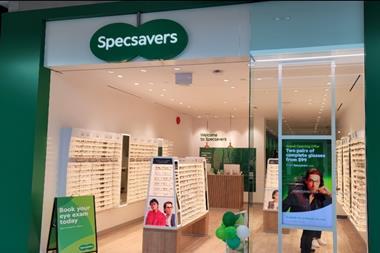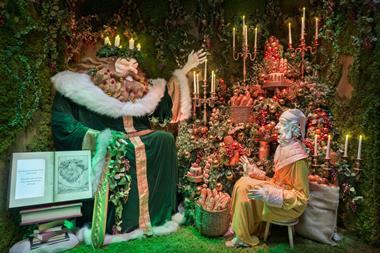Matalan’s defining proposition has always been value, but now it is making its stores more engaging places to visit. John Ryan meets chief executive Alistair McGeorge and visits the Stockport branch
Now is the visual merchandiser’s moment. As store makeovers get put on hold and the design community twiddles its collective thumbs, retailers are increasingly realising that more can be done for very considerably less - courtesy of visual merchandising. After all if it’s a matter of rethinking layouts and ensuring that stock is displayed to advantage, visual merchandising has got to be more straightforward than sweeping structural alterations. Not only do the latter tend to be expensive, but they also have a tendency to lock a store into a particular appearance and changing this is rarely easy.
And, of course, when money is tight, rolling out new ways of using what you’ve already got is probably more a matter of in-store resources than calling in shopfitters, project managers, et al. Done well, visual merchandising is a cost-effective way of “refreshing” a store interior. It is perhaps with this in mind that Matalan chief executive Alistair McGeorge decided to call in visual merchandising consultancy Visual Thinking to help reorganise what he refers to as “big spaces”.
Although Visual Thinking had been working with Matalan on its stores for a while on small(er) spaces, McGeorge says that there was a need to do something with the stores of 30,000 sq ft and above. The store at Longton, Stoke-on-Trent, served as the pilot and was completed in October last year. Since then, a modest roll-out of the new look has been in progress and McGeorge is keen to show off the Stockport branch - not least because he lives just down the road.
“The old Matalan was a great business. It was the one that had bought value to the UK. In its day it was the cheapest. I think what happened was that it lost its way. So we took a look at the whole market. We know we’ve got the biggest out-of-town fashion spaces, so we decided that what we needed to do was to add better and best ranges to our core offer,” says McGeorge.
The results unveiled by Matalan this week show that McGeorge’s plans seem to be working. In practice it has meant that shop-in-shops are very much the order of the day in the 30,000 sq ft Stockport store, as is merchandise linked with familiar designers, including Jeff Banks, Colin and Justin (the camp pair who redecorate people’s homes on TV) and Laurence Llewelyn-Bowen, among others. McGeorge is quick to point out that while this has meant segmenting the offer, it has not resulted in a store filled with branded areas to the exclusion of everything else. This, he says, would be too much like hard work if, for instance, all you wanted to do was simply to find a man’s casual shirt.
Instead, it’s about making a large space interesting and the branded shop-in-shops are one aspect of doing this. One of the problems that bedevils every retailer that has chosen to set up in a retail shed is how to carve up the available area in a manner that doesn’t make it look as if you are merchandising in a barn. “We recognise that we are an out-of-town shed, but these should still be engaging places in which to shop,” says McGeorge. He adds that, while huge amounts of money have not been lavished on each of the 180 stores that have so far been refurbished (out of an estate totalling about 200), “the whole environment, the shopfit and equipment are different from where we were two years ago”.
Stand at the front of this shop and it would be easy to see how this could be an example of the wide open space. It is classic shed territory, with a high, white roof and exposed, silver air-conditioning ducting and pipes. Yet somehow, unless you take the trouble to look up and to keep looking, it would be easy to miss this - largely owing to the impact of the visual merchandising wherever else you happen to look.
Shed heaven
The first thing you are likely to notice are the faceless white mannequins set against fuschia-coloured boards just inside the entrance. These are used to highlight women’s fashion. This is probably something of a no-brainer since, as McGeorge points out, 80 per cent of Matalan’s shoppers are female.
If you look down the long, long aisles that stretch away to the back of the shop, while you may not take in everything, you do at least register that there are things worth taking a closer look at. McGeorge says that it’s about creating changes of pace. “If everything you see is at the same pace, people get bored,” he says. He adds that in its pre-make-over form, stock would have been piled high and all of the equipment - mid-shop and perimeter - would have been at the same height. “You have to make it interesting from the moment someone walks in. It doesn’t matter how good it is at the back of the store if no one ever gets there,” he says.
To make this a reality, each of the vistas along the aisles is interrupted by a circular focal point at which a group of mannequins is positioned. All of these have high-level canopies above them, with each being given a different treatment, depending on the department and the merchandise that is involved.
If nothing else, these succeed in drawing the eye deep into the store’s interior. And along the way, your gaze strays into the branded areas. Some of these will be unfamiliar to non-Matalan shoppers, with “Be Beau” and “et vous” in the womenswear department, for instance, being used to target different customer demographics. That said, a consistency of approach is evident, with clear graphics, mood pictures and equipment that in many cases are the same, but that are laid out differently and used to achieve a sense of differentiation.
Some departments really do stand out, as much because of the merit of the stock as the visual merchandising. Footwear and M Party (Matalan Party) stand out in this respect. For footwear, the brown and cream patterned wallpaper demands attention, but this is reinforced by the brightly coloured stock positioned at the front of the mid-shop display units.
This is all to the left-hand side of the entrance, while the party shop is at the opposite end of the store - at the back, on the right. Here, the central “balloon station” - where shoppers can get all the inflation they might ever need - dominates the space. But the fancy-dress mannequins (you too can be a cowboy for £20) are the real scene-stealers, and mean that if you reach this part of the store, you’re probably going to linger. “Party is a slow burner,” says McGeorge. “If you haven’t got a party to go to, you might take a look, but you’ll only buy when you need it.”
And then there are the tills. It’s a Thursday morning and these are all busy. McGeorge seems satisfied.
“If people have got their wallets out, I want people there to take their money,” he says. “If customers can see that all the tills are manned, then they won’t mind waiting because they’ll think: ‘They’re doing their best’,” he says.
Nevertheless, there is a restless quality about the way he views the Stockport branch. “We’ve got some things right. But you have to learn. If something doesn’t work, you learn and move on,” he says.
At the moment the odds are probably stacked in Matalan’s favour. This is the time when shoppers - and there are 11 million Matalan card holders in the UK - are more conscious of value than ever. “I don’t know if the economy’s helping us. But it’s certainly doing us no harm,” says McGeorge.
Matalan will open three new stores this year, its first for two years. “There’s no point in opening more stores if you haven’t got the 200 that you’ve got right - that’s not the answer.” It would appear that a resurgent Matalan is getting something right - and with sales uplifts of about 14 per cent in the refreshed stores, payback is a matter of months rather than the two years that McGeorge says was originally set for the project.
Matalan
- Stockport store size 30,000 sq ft
- Features shop-in-shops and segmentation
- Number of refurbished stores 180 over the past two years
- Store modernisation programme cost to date £30m
- Investment in stores this year £16m
- Sales £1.04bn (year to February 28), up 2 per cent
- EBITDA £145.1m (year to February 28), up 6.3 per cent


























No comments yet